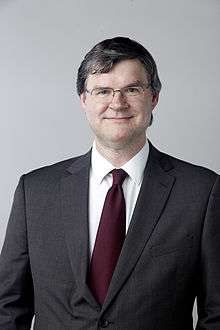David Charlton
| David Charlton | |
|---|---|
 David Charlton in 2014, portrait via the Royal Society | |
| Born | David G. Charlton |
| Fields | |
| Institutions | |
| Alma mater |
|
| Notable awards | |
|
Website www | |
David G. Charlton FRS is Professor of Particle Physics in the School of Physics and Astronomy at the University of Birmingham, UK.[2][3]
He is the Spokesperson (scientific head) of the ATLAS Collaboration at the Large Hadron Collider at CERN.[4][5] Prior to becoming Spokesperson, he was the Deputy Spokesperson for four years, and before that Physics Coordinator of ATLAS in the run-up to the start of collision data-taking. [6]
Education
Charlton was educated at the University of Oxford, graduating with a Bachelor of Arts degree in Physics in 1985. He went on to study for a PhD in Particle Physics at University of Birmingham, which he was awarded in 1989[7] for work on the UA1 experiment, searching for the top quark.[8]
Teaching
A professor at the University of Birminhgam, he conceived and led a Y3 design group studies for several years, and also introduced and taught a Y4 module “Current Topics in Particle Physics”. While Spokesperson of ATLAS his lecturing is temporarily in abeyance. [9]
Research
Charlton's research investigates the Higgs mechanism and electroweak symmetry breaking.[10][11][12][13][14][15] His research has been funded by the Science and Technology Facilities Council (STFC).[16]
Career
Charlton has been the spokesperson of the ATLAS Collaboration since March 2013. During the construction of the ATLAS experiment, he worked on hybrid readout circuits for the silicon strip sensors of the Semiconductor Tracker (SCT) detector and on the first-level calorimeter trigger system.
From 1989 to 2001, Charlton worked on the OPAL experiment of the Large Electron–Positron Collider at CERN, on data analysis, components of the trigger and data acquisition systems, and the identification of muons.
Awards and honours
Charlton was elected a Fellow of the Royal Society in 2014. His nomination reads:
| “ | David Charlton is a leader in the experimental elucidation of electroweak symmetry-breaking, culminating in the observation and first characterisation of a Higgs boson, at the LHC. His work with the OPAL experiment at the electron-positron collider LEP provided the first measurement there of the yield of Z decays, then extracted the fraction decaying to bottom quarks. Later he led the measurements which directly demonstrated the gauge structure of the electroweak sector of the Standard Model. At the LHC, he led physics preparations in the year before first collisions, acted as ATLAS Deputy Spokesperson throughout the first three year running period, and is now the collaboration spokesperson.[1] | ” |
References
- 1 2 "Professor David Charlton FRS". London: The Royal Society. Archived from the original on 2014-07-01.
- ↑ List of publications from Microsoft Academic Search
- ↑ David Charlton's publications indexed by the Scopus bibliographic database, a service provided by Elsevier. (subscription required)
- ↑ "Interviews With ATLAS Personnel: Dave Charlton". ATLAS experiment. CERN.
- ↑ Charlton, David; Heinemann, Beate. "ATLAS experiment - Public results". Twiki. CERN.
- ↑ http://www.birmingham.ac.uk/staff/profiles/physics/charlton-david.aspx
- ↑ David Charlton FRS, Professor of Particle Physics, University of Birmingham
- ↑ https://intranet.birmingham.ac.uk/buzz/documents/public/Buzz-150-June-July-2014.pdf
- ↑ http://www.birmingham.ac.uk/staff/profiles/physics/charlton-david.aspx
- ↑ The Search for the Higgs Boson at the University of Birmingham with David Charlton and Paul Newman on YouTube
- ↑ "A comparison of b and uds quark jets to gluon jets". Zeitschrift für Physik C. 1995. doi:10.1007/BF02907439.
- ↑ Akrawy, M.Z. (1989). "Measurement of the Z0 mass and width with the opal detector at LEP". Physics Letters B. 231 (4): 530–538. doi:10.1016/0370-2693(89)90705-3.
- ↑ "Observations of π-B charge-flavor correlations and resonant Bπ and BK production". Zeitschrift für Physik C. 1955. doi:10.1007/BF01496577.
- ↑ "Measurement of the Z0 line shape parameters and the electroweak couplings of charged leptons". Zeitschrift für Physik C. 1991. doi:10.1007/BF01560437.
- ↑ "A study of the general characteristics of proton-antiproton collisions at √s=0.2 to 0.9 TeV". Nuclear Physics B. 1990. doi:10.1016/0550-3213(90)90493-W.
- ↑ Research grants awarded to David Charlton Research Councils UK